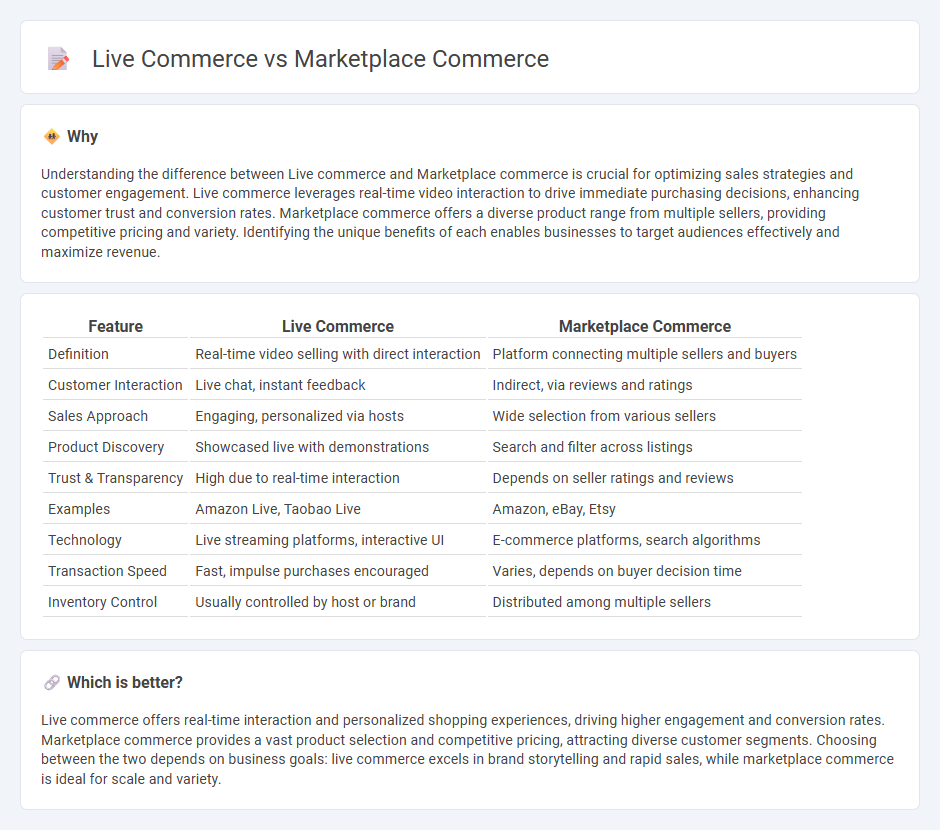
Live commerce integrates real-time video streaming with online shopping, enabling consumers to interact directly with sellers while viewing products in action. Marketplace commerce offers a digital platform where multiple vendors list products, providing a broad selection and competitive pricing within a centralized online space. Explore the key differences and benefits of live commerce and marketplace commerce to optimize your digital sales strategy.
Why it is important
Understanding the difference between Live commerce and Marketplace commerce is crucial for optimizing sales strategies and customer engagement. Live commerce leverages real-time video interaction to drive immediate purchasing decisions, enhancing customer trust and conversion rates. Marketplace commerce offers a diverse product range from multiple sellers, providing competitive pricing and variety. Identifying the unique benefits of each enables businesses to target audiences effectively and maximize revenue.
Comparison Table
| Feature | Live Commerce | Marketplace Commerce |
|---|---|---|
| Definition | Real-time video selling with direct interaction | Platform connecting multiple sellers and buyers |
| Customer Interaction | Live chat, instant feedback | Indirect, via reviews and ratings |
| Sales Approach | Engaging, personalized via hosts | Wide selection from various sellers |
| Product Discovery | Showcased live with demonstrations | Search and filter across listings |
| Trust & Transparency | High due to real-time interaction | Depends on seller ratings and reviews |
| Examples | Amazon Live, Taobao Live | Amazon, eBay, Etsy |
| Technology | Live streaming platforms, interactive UI | E-commerce platforms, search algorithms |
| Transaction Speed | Fast, impulse purchases encouraged | Varies, depends on buyer decision time |
| Inventory Control | Usually controlled by host or brand | Distributed among multiple sellers |
Which is better?
Live commerce offers real-time interaction and personalized shopping experiences, driving higher engagement and conversion rates. Marketplace commerce provides a vast product selection and competitive pricing, attracting diverse customer segments. Choosing between the two depends on business goals: live commerce excels in brand storytelling and rapid sales, while marketplace commerce is ideal for scale and variety.
Connection
Live commerce integrates real-time video streaming with e-commerce, enabling consumers to interact directly with sellers and make instant purchases, thereby enhancing customer engagement and driving sales. Marketplace commerce aggregates multiple sellers on a single platform, offering diverse products and facilitating seamless transactions between buyers and various vendors. The connection lies in live commerce leveraging marketplace infrastructure to provide interactive, multi-vendor shopping experiences that boost conversion rates and expand market reach.
Key Terms
Transaction Model
Marketplace commerce operates on a multi-vendor model where transactions occur between buyers and various third-party sellers within a centralized platform, emphasizing scalability and diverse product offerings. Live commerce integrates real-time video streaming with direct purchase options, creating an interactive transaction model that enhances consumer engagement and impulse buying through instant feedback and personalized recommendations. Explore how these transaction models impact user experience and sales strategies in digital retail.
Real-time Interaction
Marketplace commerce operates through asynchronous transactions on e-commerce platforms, where buyers and sellers complete purchases without immediate interaction, relying on product descriptions and reviews. Live commerce integrates real-time video streaming, enabling direct communication between hosts and viewers, thereby enhancing engagement and instantaneous purchasing decisions. Explore how real-time interaction transforms consumer experiences and drives sales in live commerce.
Customer Engagement
Marketplace commerce facilitates customer engagement by offering diverse product selections and user reviews, enabling informed purchase decisions through interactive browsing and rating systems. Live commerce enhances engagement through real-time video presentations, live chats, and instant purchasing, creating an immersive and interactive shopping experience that builds trust and excitement. Explore the advantages of each model to optimize your customer engagement strategy.
Source and External Links
Adobe Commerce Marketplace - A platform offering thousands of free and premium Magento extensions to extend online store functionality.
Adobe Commerce Marketplace - Experience League - An application store providing merchants verified Magento extensions and tools for developers, ensuring high quality through rigorous review processes.
AWS Marketplace Commerce Analytics Service - A service that enables programmatic access to product and customer data on AWS Marketplace for usage, subscription, and billing insights.
 dowidth.com
dowidth.com